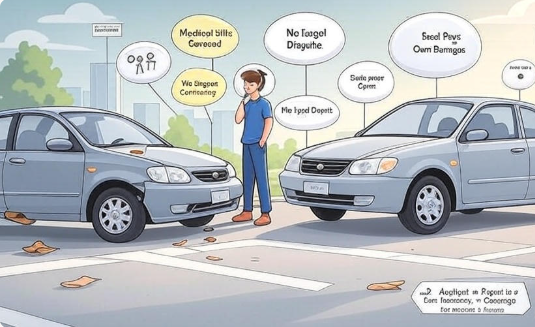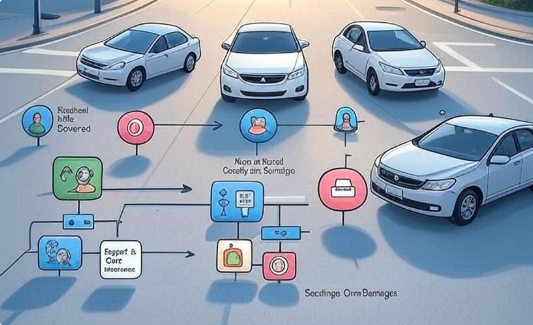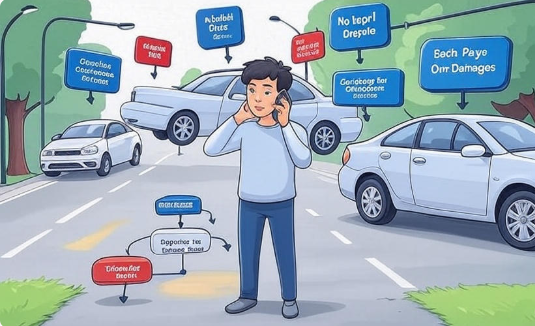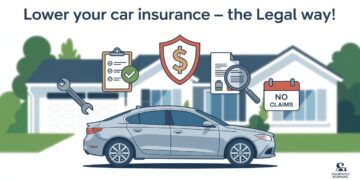Auto insurance can be complex, especially when trying to understand what happens after an accident. One of the most frequently misunderstood concepts is no-fault insurance. This system varies by jurisdiction but plays a major role in how claims are handled, especially when it comes to personal injury. In this comprehensive guide, we will break down what no-fault insurance is, how it works, the states where it applies, its advantages and disadvantages, and what you need to consider before choosing a policy.
Understanding No-Fault Insurance
What is No-Fault Insurance?
No-fault insurance, also known as Personal Injury Protection (PIP), is a type of auto insurance coverage that pays for your medical expenses, lost wages, and other out-of-pocket costs following a car accident, regardless of who was at fault. The primary goal of this system is to reduce the need for litigation by ensuring that every party involved in an accident can receive prompt compensation through their own insurance provider.
The idea is to eliminate delays and legal disputes by allowing drivers to quickly recover financial losses through their own insurance, instead of waiting for a liability claim against another driver.
Key Features
- Covers medical expenses, lost income, and sometimes funeral costs
- Limits the ability to sue unless certain thresholds are met
- Applies only to bodily injuries, not to vehicle or property damage
- Often mandatory in certain states, optional in others
How Does No-Fault Insurance Work?
In a no-fault insurance state, after an accident, each driver’s own insurance covers their medical costs and other financial losses up to the limits of their PIP coverage. This system is designed to speed up the claims process and reduce the burden on the court system. It emphasizes efficiency and focuses on treatment and recovery rather than fault-finding.
Filing a Claim
- Notify your insurance company immediately after the accident.
- Submit all relevant documentation such as medical bills, hospital records, wage loss proof, and household service receipts.
- Your insurer will process and pay out the claim, typically within a specified timeframe (e.g., 30 days), as required by state law.
When Can You Sue?
Although no-fault insurance limits the ability to file a lawsuit, you can still sue the at-fault driver under certain conditions:
- If your injuries meet a defined severity threshold (e.g., permanent disability, disfigurement, or significant impairment)
- If your medical expenses exceed the limits of your PIP coverage
- If emotional distress or pain and suffering result from a serious injury
Each state has its own threshold standards, which may be monetary (e.g., $10,000 in medical expenses) or verbal (e.g., description of injury type).
Types of No-Fault Insurance Systems
There are three main types of no-fault insurance systems, each with different rules and levels of flexibility.
Pure No-Fault
In a pure no-fault system, drivers are generally not allowed to sue for pain and suffering or other non-economic damages, regardless of the severity of their injuries. The goal is to completely remove personal injury claims from the court system. This system is very limited in the U.S.
Choice No-Fault
This model gives consumers a choice between no-fault and traditional tort liability systems. Policyholders can select the coverage that best fits their needs and legal preferences. States like New Jersey and Pennsylvania offer this model.
Add-On No-Fault
In add-on states, drivers can purchase PIP coverage to complement their standard auto insurance, but the presence of PIP doesn’t limit the right to sue. This provides more flexibility but also more responsibility in determining fault and filing claims.
What Does No-Fault Insurance Cover?
No-fault insurance typically covers the following:
- Medical Expenses: Includes emergency room visits, surgeries, ongoing treatment, medication, and physical therapy
- Lost Wages: If you’re unable to work due to accident-related injuries
- Funeral Costs: In the unfortunate event of a fatality
- Essential Services: Coverage for services like cleaning, grocery shopping, and childcare when you’re unable to perform these tasks
The exact benefits and coverage limits depend on your policy and your state’s regulations.
What’s Not Covered
- Vehicle Damage: Not included under PIP; handled via collision coverage or the at-fault driver’s liability insurance
- Other Property Damage: Damage to buildings, fences, or other personal property
- Pain and Suffering: Only covered if a lawsuit threshold is met
- Injuries to Others in Your Car: Depending on your policy, you may need additional medical payments coverage
No-Fault Insurance by State
Mandatory No-Fault States
As of now, the following 12 states have mandatory no-fault insurance laws:
- Florida
- Michigan
- New York
- New Jersey
- Pennsylvania
- Hawaii
- Kansas
- Kentucky (choice)
- Massachusetts
- Minnesota
- North Dakota
- Utah
Choice No-Fault States
These states allow drivers to choose between no-fault and traditional liability-based insurance:
- Kentucky
- New Jersey
- Pennsylvania
Add-On States
These states offer optional PIP coverage without restricting the right to sue:
- Arkansas
- Delaware
- Maryland
- New Hampshire
- Oregon
- South Dakota
- Texas
Each state has unique requirements regarding coverage limits, lawsuit thresholds, and included benefits. It’s essential to consult your state insurance department or your insurance provider for specific details.
Pros and Cons of No-Fault Insurance
Advantages
- Quick Compensation: Claims are processed faster, enabling immediate access to funds for treatment and recovery.
- Lower Legal Costs: Reduces the number of personal injury lawsuits, saving legal fees.
- Predictability: Standardized coverage simplifies claim outcomes.
- Focus on Healing: Eliminates fault-related disputes so injured parties can focus on recovery.
Disadvantages
- Limited Legal Recourse: Difficult to seek compensation for pain and suffering unless thresholds are met.
- Premium Costs: In states with generous PIP benefits, premiums can be higher.
- Potential for Fraud: The ease of access to medical reimbursement can lead to overuse or fraudulent claims.
How to Choose the Right No-Fault Insurance Policy
Choosing the right policy involves careful evaluation of your health insurance, driving habits, risk tolerance, and state regulations.
Assess Your Needs
- Do you have adequate health insurance to cover accident-related injuries?
- Do you often drive with passengers who might need protection under your policy?
- Are you concerned about lost income due to injury?
Review State Requirements
Understand what minimum PIP coverage is required in your state. States like Michigan used to mandate unlimited PIP, while others have specific dollar limits.
Consider Supplementary Options
- Medical Payments Coverage (MedPay): Helps with medical costs not covered by PIP
- Uninsured/Underinsured Motorist Coverage: Protects you in case the other party has no or insufficient insurance
- Collision Coverage: Covers damage to your car regardless of fault
Work with a Licensed Agent
An insurance agent familiar with your state laws can help you compare policies and determine appropriate coverage levels based on your personal situation.
Comparing No-Fault and At-Fault Insurance Systems
Feature |
No-Fault Insurance |
At-Fault Insurance |
|---|---|---|
Medical Bills Paid By |
Your own insurer |
At-fault driver’s insurer |
Litigation |
Limited |
Common |
Speed of Compensation |
Faster |
Slower |
Pain and Suffering Claims |
Limited |
Permitted |
Fraud Potential |
Higher |
Lower |
The Impact of No-Fault Laws on Auto Insurance Costs
No-fault insurance often brings increased administrative costs to insurers, which may be reflected in higher premiums. States like Michigan, which previously mandated unlimited PIP coverage, have seen substantial costs for drivers. However, 2019 reforms allowed drivers to choose different PIP coverage levels, potentially lowering premiums.
On the flip side, reducing litigation may save insurers money in the long term, which could be passed on to consumers in the form of discounts or stable rates.
Real-World Example: Michigan’s No-Fault Reform
Michigan historically had one of the most expensive auto insurance systems in the country due to its requirement for unlimited PIP. In 2019, the state passed reforms allowing drivers to choose from a range of PIP limits, from $50,000 to unlimited. The law also introduced a fee schedule for medical services and fraud-prevention measures.
This change has significantly altered the insurance landscape in Michigan, providing valuable insights into how no-fault reforms can affect costs and coverage.
Common Myths About No-Fault Insurance
Myth 1: No-Fault Means You’re Never at Fault
Reality: Fault still matters for property damage and may influence your premiums. No-fault only applies to bodily injury claims.
Myth 2: You Can’t Ever Sue
Reality: Lawsuits are still permitted when injuries are severe or exceed coverage thresholds.
Myth 3: PIP Covers Everything
Reality: PIP only covers specific medical and income-related expenses. You need additional coverage for your vehicle or for other people’s property.
Frequently Asked Questions
Is no-fault insurance the same as liability insurance?
No. Liability insurance pays for damage or injury you cause to others. No-fault insurance (PIP) pays for your own medical expenses and losses regardless of fault.
Do all states require no-fault insurance?
No. Only 12 states mandate it. Others may offer it as an option or not at all.
Can I choose not to have PIP coverage?
In states where PIP is optional or part of a choice system, yes. But in mandatory no-fault states, you must carry PIP.
Does no-fault insurance affect who pays for vehicle damage?
No. Vehicle damage is still handled through traditional liability or collision coverage.
How does no-fault insurance impact premiums?
Premiums may be higher due to the broad nature of PIP coverage. However, they can also be more stable because fewer claims go to court.
Can I still recover non-economic damages?
Only if your injuries meet your state’s defined threshold, either monetary or verbal.
What’s the difference between PIP and MedPay?
Both cover medical expenses, but PIP often includes lost wages and essential services, while MedPay is limited to medical costs.
Conclusion
So, what is no-fault insurance and how does it work? In essence, it’s a system designed to streamline the compensation process following a car accident by allowing drivers to receive benefits from their own insurers, regardless of who caused the accident. While it offers speed and simplicity, it also comes with limitations on lawsuits and coverage.
Understanding your state’s laws and carefully evaluating your coverage needs will help you make informed decisions about no-fault insurance. Whether you are required to carry it or are considering it as an optional add-on, knowing how it functions can make a significant difference in the aftermath of an accident.
By weighing the pros and cons, consulting with professionals, and tailoring your policy to your circumstances, you can ensure that you’re adequately protected while also controlling your insurance costs. No-fault insurance provides a safety net when you need it most—and knowing how to make it work for you can lead to better outcomes on the road and peace of mind at home.












